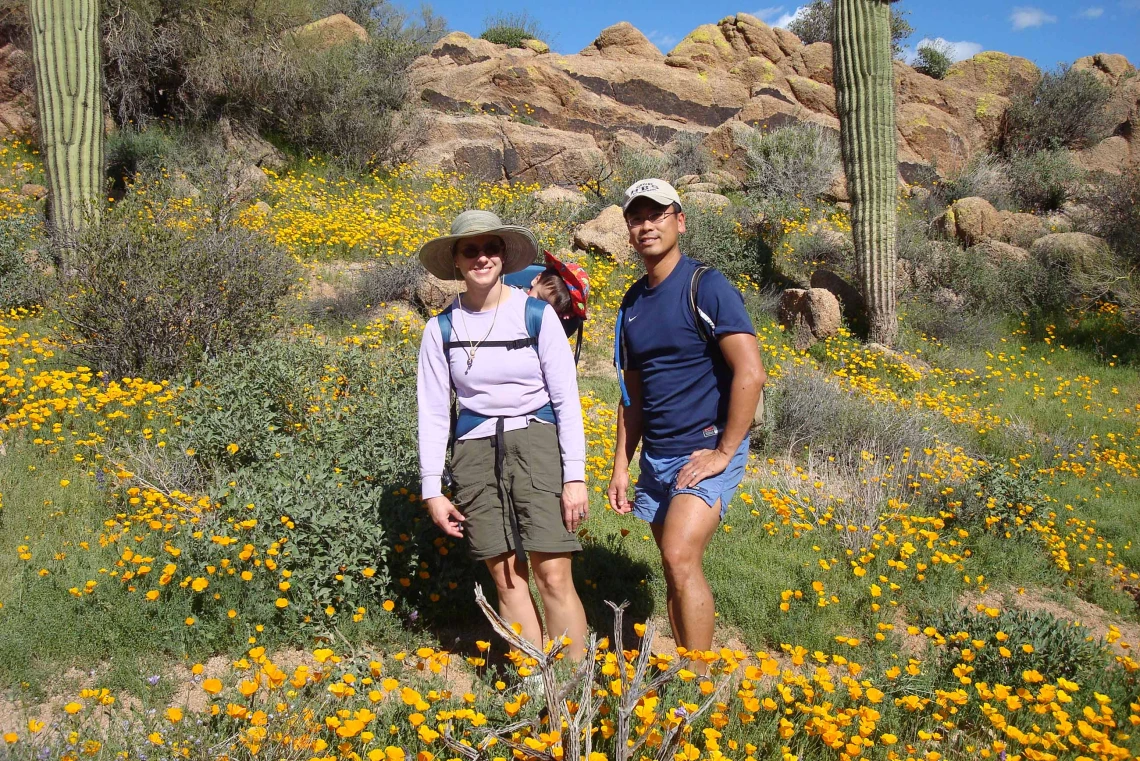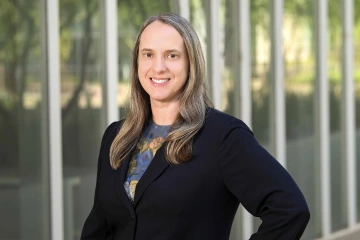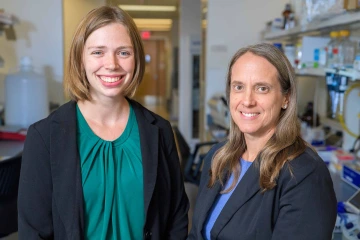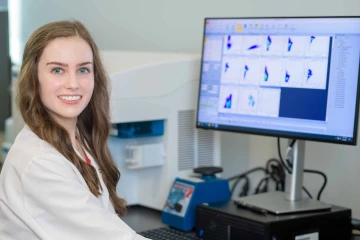Unlocking the immune system’s potential to fight skin cancer
Karen Hastings, MD, PhD, is exploring how neoantigens can be used as a target for vaccines to help fight skin cancer.

Karen Hastings, MD, PhD, pictured with her husband, Keith, was drawn to Arizona personally because of the state’s beauty and professionally because of her research into immunotherapy solutions for skin cancer.
Photo courtesy of Karen Hastings

Karen Hastings, MD, PhD, is researching how neoantigens, unique markers on cancer cells, can help the immune system recognize and fight skin cancer.
Photo by Noelle Haro-Gomez, U of A Health Sciences Office of Communications
When Karen Hastings, MD, PhD, chose to make Arizona her home, it wasn’t just the stunning desert landscapes and towering saguaros that drew her in, it was the chance to confront one of the state’s most pressing health issues: skin cancer.
Hastings is a professor and the first chair of the Department of Dermatology at the University of Arizona College of Medicine – Phoenix. She helped develop the medical school curriculum as one of the college’s founding faculty members, and her research has been crucial in advancing science that could eventually lead to the development of vaccines for skin cancer.
“I think what attracts us as scientists is following our own ideas and the opportunity to build something with those ideas,” said Hastings, whose skin cancer research focuses on antigen presentation and T cell responses. “That has been a constant for me each step of the way.”
Identifying cancer targets
Early in her career, Hastings focused on melanoma, investigating how the immune system processes and presents melanoma antigens – unique molecules on the surface of cells that serve as identification tags. These tags enable the immune system to differentiate between the body’s own cells and foreign invaders including viruses, bacteria or cancerous cells that T cells are meant to eliminate.
“In order for a T cell to see an antigen, that antigen has to be taken up by an antigen presenting cell,” Hastings explained.
For this to happen, antigens must be presented in a way that is easily detectable. This can be accomplished by major histocompatibility complex molecules, which act as display cases on the surface of cells and showcase fragments of antigens for T cells to identify.
“The antigen gets chopped up and then displayed on the cell surface on MHC molecules,” Hastings said. “The T cell sees this short fragment in the MHC, and this allows the T cell to recognize and bind to the specific antigen fragment displayed on the MHC molecule.”
“The ultimate goal is to create effective cancer vaccines.”
— Karen Hastings, MD, PhD
This complex process ensures that the immune system can effectively identify and neutralize harmful invaders. Cancer, though, presents unique challenges. Since cancer originates from the body’s own cells, it often evades immune detection.
“This is called tolerance,” said Hastings, who earned her medical and doctoral degrees from Harvard University and completed a dermatology residency and a postdoctoral fellowship in immunology at Yale University. “It is like a safety brake on the immune system, keeping it from harming all the other healthy cells in the body.”
A new home, a new target for vaccine development
In 2006, Hastings and her husband attended a dermatology conference in Tucson and were captivated by the natural beauty and open spaces of the Sonoran Desert.

(From left) MD/PhD student Elizabeth Borden is mentored by Hastings and works in her lab to explore immunoediting, a theory that describes how the immune system shapes developing skin cancers.
Photo courtesy of U of A College of Medicine – Phoenix Office of Marketing and Communications
“There’s something really relaxing about nature,” she said. “When you visit Saguaro National Park, it’s just you, the mountains and saguaros. I fell in love with the wide-open spaces.”
She was also drawn to Arizona because of how the region aligns with her research interests. The state’s high UV index and nearly year-round sunshine leads to high rates of skin cancer. According to the National Cancer Institute, Arizona averaged 28.9 melanoma cases per 100,000 residents from 2016 to 2020, which is well above the national average of 22.5.
“Coming to Arizona, with our high UV index, it’s a very important problem to investigate here,” said Hastings, whose laboratory works to identify novel ways to harness T cells to fight cancer.
About eight years ago, Hastings began a new chapter in her research as she recognized the potential to overcome the challenges posed by immune tolerance. Hastings is interested in neoantigens – unique antigens created by cancer mutations that serve as red flags for the immune system. Unlike normal antigens, neoantigens are more likely to be recognized by the immune system as threats.
“The immune system has this property of tolerance, but mutated proteins from a cancer are different than anything your body has,” Hastings said. “This is why the immune system can see the neoantigens better.”
Hastings’ current studies revolve around developing a cancer vaccine based on these promising neoantigens.
Anngela Adams and Elizabeth Borden, who are both in the MD/PhD program at the U of A College of Medicine – Phoenix, played pivotal roles in advancing research into cutaneous squamous cell carcinoma.
Adams, who is now in medical school, completed her doctorate in Clinical Translational Sciences through the U of A College of Health Sciences last year. She received a fellowship training grant from the National Cancer Institute to continue investigating the role of neoantigen-specific T cells in cutaneous squamous cell carcinoma using a novel mouse model she developed in Hastings’ laboratory.
Borden, who will finish her doctorate in Clinical Translational Sciences through the College of Health Sciences this spring, also received an NCI fellowship training grant to support her computational work on immunoediting in cutaneous squamous cell carcinoma. She is comparing the profile of mutated peptides in cutaneous squamous cell carcinoma from immunosuppressed and immunocompetent individuals to identify changes in the neoantigen profile that are due to intact immune system.

Under Hastings’ guidance, MD/PhD student Anngela Adams developed a way to study skin cancer by utilizing a solar-simulated, light-induced cutaneous squamous cell carcinoma mouse model that closely mimics the human disease.
Photo courtesy of U of A College of Medicine – Phoenix Office of Marketing and Communications
Together, their efforts have significantly expanded scientific understanding of how neoantigens can be recognized by T cells, enabling the immune system to target and destroy tumors.
Identifying which neoantigens to target for the most effective treatment, though, is not simple. When it comes to skin cancer, ultraviolet light exposure can cause thousands of DNA mutations.
“Right now, we have clinical studies where you can have personalized mRNA vaccines to treat cancer, but you can only select maybe 20 or so of those antigens to put in the vaccine,” Hastings said. “We are trying to narrow down the thousands of mutations that are present to the ones that will be the most effective.”
To help address this challenge, Hastings and her team developed the “NeoScore,” a mathematical model that evaluates each neoantigen based on factors such as its stability and its ability to bind to the MHC molecule. The NeoScore helps identify the most promising neoantigens for vaccine development.
“The NeoScore takes into consideration many characteristics to create an overall immunogenicity score for each neoantigen, so they can be sorted and ranked,” Hastings said. “Still, immunogenicity is complicated, and sometimes the score we get does not correlate with how effective the neoantigen actually is. We are continuing to refine the selection process.”
Hastings’ work aims to overcome tolerance and unlock the full potential of the immune system to fight cancer by improving the selection and refinement of neoantigens. She envisions a future where a simple vaccine could provide protection against a wide-spread and potentially devastating disease.
“The ultimate goal is to create effective cancer vaccines,” she said. “By improving the way we identify and prioritize neoantigens, we can take significant steps toward that vision.”
Experts
Karen Taraszka Hastings, MD, PhD
Professor and Chair, Department of Dermatology, U of A College of Medicine – Phoenix
Professor, Department of Basic Medical Sciences, U of A College of Medicine – Phoenix
Professor, Department of Immunobiology, U of A College of Medicine – Tucson
Professor, Clinical Translational Sciences, U of A College of Health Sciences
Member, U of A Cancer Center, U of A Health Sciences
Contact
Blair Willis
U of A Health Sciences Office of Communications
520-419-2979, bmw23@arizona.edu

